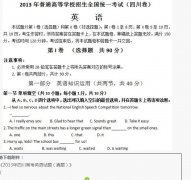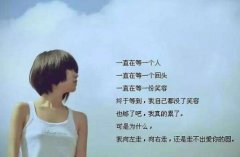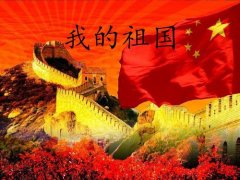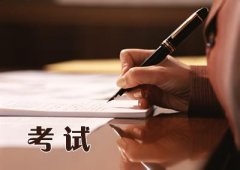外研社SB4 MODULE 1 FUREU LIFE 同步完型填空(9)
6.After the law was passed, the prisoners in that state are ________ two hours' outdoor exercise a day.
A.promised B.agreed
C.permitted D.admitted
解析:选C。句意:法律通过后,那个州的囚犯一天允许在户外活动两个小时。permit“允许”,符合句意。promise“许诺”;agree “同意”;admit“承认”。
7.________, I think, and the problem could be settled.
A.So long as you keep up your spirits
B.A bit more effort
C.If you doubt your effort
D.Making great effort
解析:选B。句意:我认为再努力点,就能解决那个问题。题干为“名词词组+and+陈述句”句型。其他三项不符合句子结构的要求。
8.— Look! Everything here is under ________.
— Yes. The old city is being built into a new one.
A.construction B.condition
C.surrounding D.discussion
解析:选A。under construction“在建设中”。句意:“看,到处都在建设中。”“是的,这座老城正被建成一座新城。”其余选项与句意不符。
9.The Panama Canal ________ the Atlantic ________ the Pacific.
A.connects; with B.joins; with
C.unites; with D.joins; up
解析:选A。句意:巴拿马运河把大西洋和太平洋连接起来。join ... to/and ...“把……和……连接起来”;unite“联合,联手,团结,统一”;connect ... with ... “通过某种媒介物把……和……相连”。根据句意,选A项。
10.If you want to travel in this city, you'd better rent a car. It is not easy to ________ by bus here.
A.get along B.get away
C.get around D.get over
解析:选C。get around“到处旅游,四处看看”。句意:如果你想在这座城市旅游,你最好租辆车,在这儿乘公交车到处旅游不容易。get along“进展”;get away“摆脱掉”;get over“克服”。
Ⅲ.语境翻译
在大城市,印象最深刻的是车辆太多。例如与电线相连的电车,地铁,出租车,私家车,双层公共汽车等。你会经常遇到交通堵塞,甚至会被困在里面很长时间。你还会看到许多正在建设中的道路、楼房。政府应该仔细规划城市,使得人们的生活、工作和出行都很方便。
In_a_big_city,_the_most_impressive_is_too_many_vehicles_such_as_trolleybuses_connected_to_wires,_underground,_cabs,_private_cars_and_doubledeckers._You_often_meet_traffic_jams_and_even_are_stuck_in_it_for_a_long_time._You_also_can_see_many_roads_and_buildings_under_construction_every_day._The_government_should_design_the_city_carefully_and_makes_it_convenient_for_people_to_live,_work_and_get_around.
Ⅳ.阅读理解
A
The amount of time that people spend on travel is 1.1 hours per person per day in all societies. The average distance traveled is 7,400 miles (12,000 km) per year. In total, the world population travels more than 16.6 trillion miles (23 trillion km) per year, 53% of which is by car, 26% by bus, 9% by rail, 9% by highspeed transport such as airplanes, and 3% by bicycle, boat and other means.
It is estimated (估计) that, due to developments in highspeed public transport, travel time will drop to only 12 minutes per person per day by 2050. Of the global traffic volume, 35% will be by car, 20% by bus, 41% by highspeed transport, and 4% by rail.
At present, traffic congestion (拥塞) has a huge negative (消极的) economic and environmental impact(影响) across the world. Road congestion in the UK costs the UK economy 15 billion a year. It costs the US $ 100 billion a year. In Seattle, Washington for instance, a driver spends an average (平均) of 59 hours stuck in traffic each year. In the greater Seattle area there are more cars than people; each household makes an average of 10 motorcar trips a day. According to Sierra Club, “American cars and trucks account for 20 percent of the world's petroleum consumption(石油消耗).”
The US has the most highways, but European roads are busier. In Europe, cars travel more than 600 miles (1,000 km) per road per year, compared to an average of 500 km per road in the US. The world's worst traffic jam usually occurs during the summer on the road from Paris to Toulouse, France.
So take a hike. You can use Google's public transport trip planner. Or, in the least, find a job closer to home.
| 语篇解读:现在全球过半的人选择自己驾车出行,这给交通造成了很大的压力。 |
A.The car. B.The bus.
C.The train. D.The airplane.
解析:选A。细节理解题。根据第一段的“In total, the world population travels more than 16.6 trillion miles (23 trillion km) per year, 53% of which is by car”可知小汽车是目前主要的出行工具。
2.Compared to today, we know in 2050,________.
A.more people will choose to travel by train
B.more people will have a car of their own
C.a lot more people will choose the bus to go out
D.a lot more people will choose highspeed transport
解析:选D。细节理解题。根据第二段的41%by highspeed transport可知到2050年,41%的人会选择高速交通工具,这比目前的9%高了很多,故选D项。
3.What does Paragraph 3 suggest?
A.Traffic congestion is a major problem for some countries.
B.Traffic congestion will be more serious in the following years.
C.Traffic congestion is a problem for global economic development.
D.America has more cars than any other country around the world.
解析:选C。推理判断题。根据第三段的“At present, traffic congestion (拥塞) has a huge negative (消极的) economic and environmental impact (影响) across the world. Road congestion in ...”可知交通阻塞严重影响了全球经济的发展,故选C项。
4.From the passage, we learn that in the greater Seattle area, ________.
A.people are not encouraged to go out by bus
B.few people travel by train
C.every person owns a car
D.the traffic is very bad




